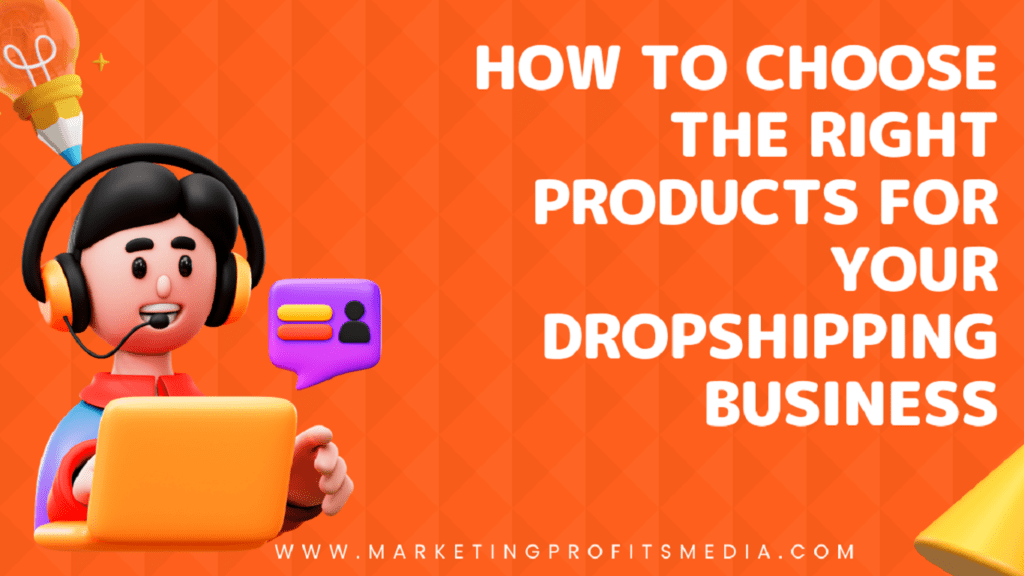Starting a dropshipping business can be an exciting venture, offering the opportunity to sell products without the need for inventory management or shipping logistics. However, selecting the right products to sell is crucial for the success of your dropshipping business. In this article, we will discuss five essential points to consider when choosing products for your dropshipping business.
My Best Easiest & Proven Way to Make $100-$300 Daily With 0 Investment – Watch THIS Training to START >>

1. Identify a Niche
Selecting a niche market is the first step towards finding success in dropshipping. Focusing on a single niche rather than offering a variety of items enables you to reach a more targeted audience and position yourself as an authority in that topic. Conduct market research to identify trends, gaps, and potential demand within your chosen niche. You may choose items that are more likely to sell successfully by being aware of the demands and preferences of your target market.
2. Evaluate Product Demand
Before adding a product to your dropshipping catalog, it’s important to assess its demand in the market.Look for items that are in great demand but are hard to get locally or have limited supply. Social networking platforms, keyword research, and Google Trends are some examples of tools that might provide helpful insights about the popularity of certain items. Additionally, check online marketplaces and competitor websites to gauge the demand for similar products.
3.Consider Product Quality and Reliability
To build a sustainable dropshipping business, it’s essential to choose products that are of high quality and reliable. Partner with suppliers who can provide products that meet customer expectations and have a track record of delivering quality items. Read product reviews and customer feedback to gauge the overall satisfaction of previous buyers. By offering superior products, you can ensure customer satisfaction, positive reviews, and repeat business.
4. Analyze Profit Margins
While picking items with high demand is crucial, you also need to take profit margins into account. Subtract the product cost (including delivery) from the selling price to get the possible profit for each item. Take into account any additional fees such as transaction fees, platform charges, or marketing expenses. Opt for products that offer a reasonable profit margin to ensure your business remains profitable and sustainable in the long run.
5. Check Shipping and Delivery Options
Shipping times and costs can greatly impact customer satisfaction. Before finalizing your product selection, ensure that your suppliers offer reliable shipping and delivery options. Look for suppliers who have a track record of delivering products in a timely manner and offer affordable or free shipping. Long shipping times and high shipping costs can deter potential customers, leading to lost sales and a negative reputation for your business.
Identify a Niche
Selecting a niche is a crucial step when starting a dropshipping business. By focusing on a specific market segment, you can tailor your product selection and marketing efforts to cater to a targeted audience. In this article, we will explore six essential points to consider when identifying a niche for your dropshipping business.
My Best Easiest & Proven Way to Make $100-$300 Daily With 0 Investment – Watch THIS Training to START >>
- Research Market Trends: Stay up to date with the latest market trends and identify emerging industries or product categories that show potential for growth. Look for niche markets that are underserved or have limited competition, as this can present lucrative opportunities for your dropshipping business.
- Analyze Audience Demographics: Understanding your target audience is vital in choosing the right niche. Conduct thorough research to identify the demographics, preferences, and purchasing behaviors of your potential customers. This information will guide you in selecting products that resonate with your audience and meet their specific needs.
- Passion and Expertise: Consider your own passions and expertise when choosing a niche. Selecting a niche that aligns with your interests will not only make your work more enjoyable but also position you as an authority in your chosen field. Your passion and knowledge will shine through in your marketing efforts, fostering trust and connection with your customers.
- Profitability Potential: While passion is important, it’s crucial to evaluate the profitability potential of your chosen niche. Look for niches that have a proven market demand and offer sufficient profit margins. Consider factors such as product pricing, competition, and the potential for repeat business or upselling complementary products.
- Longevity and Evergreen Niches: Choose a niche that has long-term potential and is not dependent on fleeting trends. Evergreen niches, such as health and wellness, beauty, or pet care, are consistently in demand and can provide sustainable growth for your dropshipping business. Avoid niches that are highly seasonal or fad-driven, as they may lead to inconsistent sales.
- Unique Selling Proposition (USP): Differentiate your dropshipping business by identifying a unique selling proposition within your chosen niche. Determine what sets you apart from competitors and how you can offer additional value to customers. It could be providing exceptional customer service, offering exclusive product variations, or specializing in a specific sub-niche within your chosen market segment.
Selecting a niche is a crucial step in building a successful dropshipping business. By thoroughly researching market trends, analyzing audience demographics, considering your passion and expertise, evaluating profitability potential, focusing on evergreen niches, and developing a unique selling proposition, you can position your business for long-term success. Remember, a well-chosen niche will not only attract customers but also provide you with a competitive edge in the dynamic world of dropshipping.
Evaluate Product Demand
Assessing product demand is a crucial aspect of choosing the right products for your dropshipping business. By understanding what customers are looking for and what is in high demand, you can increase your chances of success. In this article, we will explore six essential points to consider when evaluating product demand for your dropshipping business.
- Conduct Market Research: Thoroughly research your target market to identify current trends, consumer preferences, and purchasing behaviors. Analyze online platforms, social media, and industry reports to gain insights into the products that are popular and in demand.
- Identify Niche-specific Demands: Within your chosen niche, identify specific product demands or gaps in the market. Look for unique variations or specialized products that cater to specific customer needs. This will help you stand out from competitors and cater to a more targeted audience.
- Utilize Keyword Research: Use keyword research tools to identify popular search terms and phrases related to your niche and potential products. This will provide valuable information about the demand for specific products and allow you to optimize your product listings for better visibility in search engines.
- Analyze Competitor Offerings: Study your competitors and analyze their product offerings. Look for products that are consistently selling well for them. This indicates strong demand within the market. Additionally, identify any gaps or areas where you can offer better or unique products to gain a competitive advantage.
- Seek Customer Feedback: Engage with potential customers through surveys, forums, or social media platforms to gather feedback on product preferences and demands. This direct interaction with your target audience can provide valuable insights into their needs, pain points, and desires, helping you select products that meet their expectations.
- Test with Small Batches: Before committing to a large inventory, test product demand by sourcing small batches or utilizing dropshipping suppliers with low minimum order quantities. This allows you to gauge customer interest and demand before investing significant resources. Based on the response, you can scale up or pivot to different products accordingly.
Evaluating product demand is a crucial step in selecting the right products for your dropshipping business. By conducting thorough market research, identifying niche-specific demands, utilizing keyword research, analyzing competitor offerings, seeking customer feedback, and testing with small batches, you can make informed decisions that align with customer preferences and maximize your chances of success. Remember, understanding and meeting the demand of your target market is key to driving sales and building a profitable dropshipping business.
Consider Product Quality and Reliability
For your dropshipping company to be successful over the long term, you must guarantee product quality and dependability. When clients obtain high-quality goods that live up to their expectations, trust is established, favorable evaluations are fostered, and repeat business is stimulated. In this post, we’ll look at six crucial factors to take into account when assessing the dependability and quality of your dropshipping products.
My Best Easiest & Proven Way to Make $100-$300 Daily With 0 Investment – Watch THIS Training to START >>
- Research Supplier Reputability: Partner with reputable suppliers who have a track record of delivering quality products. Read reviews, check their ratings, and assess their reputation in the industry. Look for suppliers with established quality control processes to ensure consistent product standards.
- Request Samples: Request samples of potential products to assess their quality firsthand. Examine the materials, craftsmanship, and overall durability. By testing the products yourself, you can make informed decisions about their suitability for your customers.
- Read Customer Reviews: Customer reviews offer valuable insights into product quality and reliability. Read reviews from previous buyers to understand their experiences with the product and the supplier. Look for consistent positive feedback and address any concerns or recurring issues mentioned in the reviews.
- Consider Product Certifications: Certain products may require certifications to meet safety, quality, or industry standards. Depending on your niche, verify if the products you plan to sell have the necessary certifications. This ensures compliance and gives customers confidence in the product’s quality and reliability.
- Evaluate Return and Refund Policies: Check the return and refund policies of your suppliers to ensure they offer fair terms in case of product defects or customer dissatisfaction. A supplier with a customer-friendly return policy demonstrates their commitment to customer satisfaction and provides a safety net for your business.
- Communication and Responsiveness: Engage in direct communication with your suppliers to gauge their responsiveness and willingness to address any product-related concerns or inquiries. Prompt and effective communication is crucial for resolving issues and ensuring a smooth customer experience.
Considering product quality and reliability is paramount for the success of your dropshipping business. By researching supplier reputability, requesting samples, reading customer reviews, considering product certifications, evaluating return and refund policies, and assessing communication and responsiveness, you can select products that meet high standards and exceed customer expectations. Remember, delivering quality products not only builds customer trust but also fosters positive brand reputation and encourages long-term business growth.
Analyze Profit Margins
Analyzing profit margins is a crucial aspect of selecting the right products for your dropshipping business. By understanding the financial viability of each product, you can ensure profitability and make informed decisions that drive the success of your business. In this article, we will explore six essential points to consider when analyzing profit margins for your dropshipping business.
- Calculate the total costs for each product, including the cost of the goods from the supplier, shipping costs, transaction costs, platform fees, marketing costs, and any other expenditures. You can clearly see the profit margin for each product by correctly calculating the total expenses.
- Consider Pricing Competitiveness: Analyze the pricing of similar products in the market to understand the competitive landscape. While it’s important to offer competitive prices, avoid underpricing your products, as it can erode profit margins. Strike a balance between competitive pricing and maintaining healthy profit margins.
- Evaluate Supplier Pricing: Assess the pricing structure of your suppliers and negotiate for better prices or discounts for bulk orders. Lower product costs from suppliers can significantly impact your profit margins, allowing you to offer competitive prices while maintaining profitability.
- Factor in Seasonal Variations: Consider the seasonality of certain products and how it may affect demand and pricing. Some products may experience higher demand and pricing during specific seasons or holidays. Adjust your profit margins accordingly to account for potential fluctuations in sales and pricing throughout the year.
- Upselling and Cross-selling Opportunities: Identify products that complement your existing product offerings and create opportunities for upselling or cross-selling. By offering related products or product bundles, you can increase the average order value and boost your profit margins.
- Monitor and Adjust: Regularly monitor your profit margins and make adjustments as needed. Continuously assess the performance of your products, identify low-margin or low-performing items, and consider replacing them with higher-margin products. Keep an eye on market trends and adjust your product selection to capitalize on emerging opportunities.
Analyzing profit margins is vital for the success and sustainability of your dropshipping business. By calculating total costs, considering pricing competitiveness, evaluating supplier pricing, factoring in seasonal variations, identifying upselling opportunities, and monitoring and adjusting your product selection, you can optimize your profit margins and ensure long-term profitability. Remember, a thorough analysis of profit margins allows you to make strategic decisions that maximize revenue and drive the growth of your dropshipping business.
Check Shipping and Delivery Options
Checking shipping and delivery options is a crucial consideration when selecting products for your dropshipping business. Efficient and reliable shipping processes are essential to ensure customer satisfaction and maintain a positive reputation. In this article, we will explore six essential points to consider when checking shipping and delivery options for your dropshipping business.
- Assess Supplier’s Shipping Methods: Evaluate the shipping methods offered by your suppliers. Look for options that are reliable, fast, and provide tracking information. Consider suppliers who offer multiple shipping carriers to provide flexibility and meet the diverse needs of your customers.
- Analyze Shipping Costs: Evaluate the shipping costs associated with each product. High shipping costs can deter customers from completing their purchases. Seek suppliers who offer competitive shipping rates or consider negotiating bulk shipping discounts to optimize your profit margins.
- Estimate Shipping Times: Consider the estimated shipping times provided by your suppliers. Long shipping times can lead to customer dissatisfaction and increased refund requests. Choose suppliers that offer reasonable delivery times, preferably within the expectations of your target audience.
- Check International Shipping Options: If you plan to cater to an international customer base, verify that your suppliers offer international shipping options. Consider suppliers with experience in shipping internationally to ensure smooth customs clearance and efficient delivery to customers worldwide.
- Evaluate Packaging and Branding Options: Assess the packaging and branding options provided by your suppliers. Packaging plays a crucial role in delivering a positive unboxing experience for customers. Look for suppliers who offer customized packaging or branding options that align with your brand image.
- Review Supplier’s Return Policy: Check your supplier’s return policy to understand their process for handling returns and exchanges. A supplier with a customer-friendly return policy can enhance customer trust and satisfaction. Ensure that the return policy aligns with your own customer service standards.
Checking shipping and delivery options is essential for a successful dropshipping business. You may provide your consumers a flawless shipping experience by looking at the supplier’s shipping choices, pricing, return policies, estimated shipment times, foreign shipping options, packaging and branding options, and international shipping options. Remember, efficient shipping processes contribute to customer satisfaction, positive reviews, and repeat business, which are crucial for the growth and success of your dropshipping business.
Conclusion
Selecting the right products is a critical decision for the success of your dropshipping business. By following these five points, you can make informed choices that align with your niche, meet customer demands, and ensure profitability. Remember to thoroughly research your target audience, evaluate product demand, consider product quality and reliability, analyze profit margins, and assess shipping options. With careful planning and thoughtful selection, you can build a successful dropshipping business that caters to your customers’ needs and generates consistent revenue.
My Best Easiest & Proven Way to Make $100-$300 Daily With 0 Investment – Watch THIS Training to START >>
Thanks for reading my article on How to Choose the Right Products for Your Dropshipping Business









